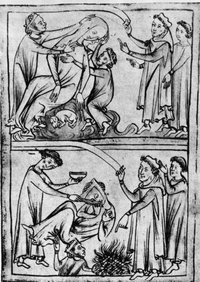The Dark Origins Of Valentine's Day
Valentine's Day is a time to celebrate romance and love and kissy-face fealty. But the origins of this festival of candy and cupids are actually dark, bloody — and a bit muddled.

As the years went on, the holiday grew sweeter. Chaucer and Shakespeare romanticized it in their work, and it gained popularity throughout Britain and the rest of Europe. Handmade paper cards became the tokens-du-jour in the Middle Ages.
Eventually, the tradition made its way to the New World. The industrial revolution ushered in factory-made cards in the 19th century. And in 1913, Hallmark Cards of Kansas City, Mo., began mass producing valentines. February has not been the same since.
Today, the holiday is big business: According to market research firm IBIS World, Valentine's Day sales reached $17.6 billion last year; this year's sales are expected to total $18.6 billion.
But that commercialization has spoiled the day for many. Helen Fisher, a sociologist at Rutgers University, says we have only ourselves to blame.
"This isn't a command performance," she says. "If people didn't want to buy Hallmark cards, they would not be bought, and Hallmark would go out of business."
And so the celebration of Valentine's Day goes on, in varied ways. Many will break the bank buying jewelry and flowers for their beloveds. Others will celebrate in a SAD (that's Single Awareness Day) way, dining alone and binging on self-gifted chocolates. A few may even be spending this day the same way the early Romans did. But let's not go there.
Hi! I am a robot. I just upvoted you! I found similar content that readers might be interested in:
https://www.npr.org/2011/02/14/133693152/the-dark-origins-of-valentines-day